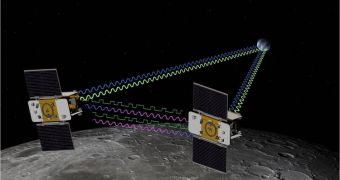On March 6, two spacecraft that entered lunar orbit recently began their science mission. Their goal, according to mission controllers at NASA, is to compile a high-resolution map of the Moon's gravitational field.
The NASA Gravity Recovery And Interior Laboratory (GRAIL) started collecting science data at 5:15 pm PST (0115 GMT, March 7), from a near-polar, near-circular orbit. They are scheduled to continue doing so until at least May 29.
For 84 days, the probes will fly a very precise distance away from each other, keeping tabs on each other's positions via radio signals. Scientists say that this distance will be affected by lunar gravity.
For example, if the spacecraft pass over a denser portion of the lunar crust – which therefore exerts more gravitational pull than other areas – the first spacecraft will be slowed down a bit. However, this change in speed is detectable via the instruments aboard GRAIL.
By analyzing data collected during scenarios such as this, experts hope to be able to convert the small speed variations into a high-resolution map of the Moon's gravitational field. They say that this could come in very handy during future exploration missions.
In addition, the investigation may also provide an unprecedented view into the composition and internal structure of Earth's natural satellite. These data may then be used to gain a deeper understanding of how the solar system itself formed.
GRAIL is made up of two identical probes, recently renamed Ebb and Flow. They arrived in orbit around the Moon on December 31, 2011 and January 1, 2012, respectively, and have been undergoing testing and commissioning ever since.
“We are in a near-polar, near-circular orbit with an average altitude of about 34 miles (55 kilometers) right now,” GRAIL project manager David Lehman explains. He holds an appointment as a scientist with the NASA Jet Propulsion Laboratory (JPL), in Pasadena, California.
“During the science phase, our spacecraft will orbit the Moon as high as 31 miles (51 kilometers) and as low as 10 miles (16 kilometers). They will get as close to each other as 40 miles (65 kilometers) and as far apart as 140 miles (225 kilometers),” he goes on to say.
“The initiation of science data collection is a time when the team lets out a collective sigh of relief because we are finally doing what we came to do, but it is also a time where we have to put the coffee pot on, roll up our sleeves and get to work,” Maria Zuber adds.
The expert, who is based at the Massachusetts Institute of Technology (MIT), in Cambridge, is the principal investigator for the GRAIL mission.

 14 DAY TRIAL //
14 DAY TRIAL //